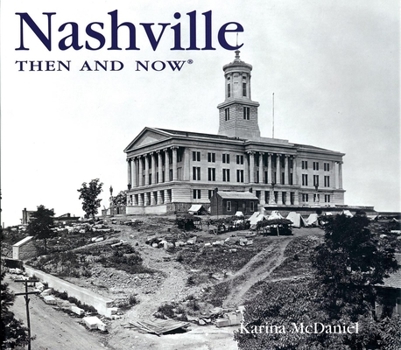Nashville Then and Now
Select Format
Select Condition 
Book Overview
Known today as the Country Music Capital of the World, Nashville was first settled by Native Americans as early as 8000 BC. French fur traders arrived around 1717, and by 1779, 'Fort Nashborough' was... This description may be from another edition of this product.
Format:Hardcover
Language:English
ISBN:1592235034
ISBN13:9781592235032
Release Date:November 2005
Publisher:Thunder Bay Press
Length:144 Pages
Weight:2.25 lbs.
Dimensions:0.6" x 9.8" x 11.4"
Customer Reviews
3 ratings
Very Well Done
Published by Thriftbooks.com User , 17 years ago
An excellent visual overview of historic downtown Nashville. With just enough dialog to provide perspective, Nashville Then and Now lets the photos do the talking. Whether you are a newcomer to Nashville, a visitor or a long-time resident who wants to look back "at the days when", this book provides an interesting overview. In hardcover, it is a great coffeetable volume and conversation starter.
Nashville Then (As I knew It) and Now
Published by Thriftbooks.com User , 18 years ago
As one born and raised in Nashville, I feel eminently qualified to review this book. The photo quality of the "Now" pages is excellent. The photo quality of the "Then" pages is excellent, considering the age of some of the pictures, such as the one of the capitol building that dates to Civil War time. If you are from Nashville, thinking of moving there or just want to see what many scenes in the town looked like in the past and today, this book is an excellent choice. You can't beat the price, either. Some of the "Then" scenes, I remember from my childhood. An excellent job all around.
Photo Journal is both nostalgic and contemporary
Published by Thriftbooks.com User , 19 years ago
Long-time Nashville residents remember the city during the 1940s, 50s, and 60s, when downtown was a bustling business district, especially Church Street and Fifth Avenue. There were various department stores (Harvey's, Castner-Knott, Cain-Sloan, Montgomery-Ward, Sears-Roebuck, Grant's, and Loveman's), five-and-ten-cent stores (Woolworth, McLellans, and Kress), and movie theaters (Paramount, Tennessee, Fifth Avenue, Knickerbocker, Loews, and Crescent). This was at a time before the exodus of such establishments to suburban shopping malls. Using some extraordinary images from the city's past, paired with the same views today, Nashville Then and Now offers a visual tour of the city's most enduring landmarks, showing how the city has developed over the years. With side-by-side archival and contemporary photos, the book shows the Parthenon in Centennial Park, a building constructed for the Tennessee Centennial in 1897; Andrew Jackson's Hermitage; and homes and businesses in Germantown (north of the Capitol) and Edgefield (East Nashville). During the Civil War, writes the author, Nashville was "the most heavily fortified city in North America," a key supply base for the Union army's campaigns in the western theater. The book's cover features a picture of the state's Capitol taken in 1862, showing Union troops camped on the grounds. Another photo compares the original Fort Negley, built in 1862 on St. Cloud Hill, with the restored fort, which was opened to the public in Dec. 2004. In the background is the modern skyline of Nashville. The text was written by Karina McDaniel, a Nashville resident who came to Tennessee from her native Germany by way of Brazil and Waterloo, Alabama. McDaniel operates the photographic section for the Tennessee State Library and Archives specializing in the restoration, reproduction and preservation of historic photographs and documents. Contemporary photographs were taken by Aubrey Watson, a lifelong resident of Nashville. Watson is a freelance photographer, lecturer and writer whose work has been published in books, magazines, corporate annual reports and advertisements. The Andrew Jackson Hotel stood at the southeast corner of Sixth Avenue North and Deaderick Street. With 350 rooms, the 12-storey building, at that time the largest hotel in Tennessee, was equipped "with every known modern convenience including a luxurious bath and telephone." It was demolished on June 13, 1971. The 240-room, six-storey Maxwell House Hotel opened for business in 1869 and advertised steam heat, gas lighting, and a bath on every floor. It was destroyed by fire on Christmas night 1961. The Hermitage Hotel, Nashville's first million-dollar hotel, which opened in 1910 and advertised its rooms as "fireproof, dustproof, and soundproof, with prices starting at $2 a night." Other photos show the Ryman Auditorium, the "mother church" of country music, which was for many years the home of the Grand Ole Opry; Music Row on 16th Ave. South;






